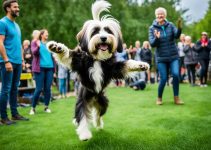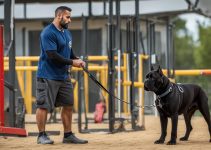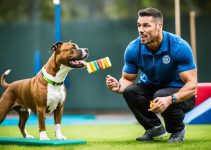Preparing the sweet, gentle Cavalier King Charles Spaniel to follow good behavior guidelines isn’t tricky. This graceful, fun-loving toy spaniel only wants to please you. With some planning, persistence, and a positive outlook, your puppy quickly takes to training. Setting up goals for socialization, leash and potty training, grooming, and basic commands are recommended in the early stages of your puppy’s development. Check out and learn more about Cavalier King Charles Spaniel training.
Cavalier King Charles Spaniel Training
- Cavalier King Charles Spaniels are eager to please and respond well to positive reinforcement training techniques.
- Socialization during the critical period between 3 and 12 weeks is crucial for a well-rounded and confident dog.
- Setting training goals for housebreaking, basic obedience commands, and leash training is essential for a well-behaved Cavalier King Charles Spaniel.
- Consistency, patience, and a gentle approach are key to successful training.
- Proper socialization and training can help prevent behavioral issues and ensure a happy and obedient companion.
Socialization and Early Training
The critical socialization period for Cavalier King Charles Spaniels begins at 3 weeks and ends at 12 weeks. During this time, it is crucial for puppies to have positive interactions with their littermates, people, noises, and sounds.
Breeders play a significant role in early socialization, handling the puppies daily from birth and exposing them to various situations. It is recommended to invite well-behaved adults and children to meet the puppies, ensuring they follow proper hygiene to avoid transmitting any diseases.
Remaining with their mother, littermates, and other dogs until they are 11 to 12 weeks old helps them build their social skills.
Basic Training and Housebreaking
When it comes to Cavalier King Charles Spaniel training, basic manners play a crucial role. To ensure your furry friend grows up to be well-behaved and obedient, it’s important to set clear training goals. These goals should include housetraining, teaching your pup to sleep quietly through the night, crate training, appropriate chewing habits, and discouraging unwanted behaviors like begging, jumping, and pulling on the leash.
The key to successful Cavalier King Charles Spaniel training is positive reinforcement. Using rewards and treats, such as small pieces of dog-friendly food, motivates your pup and makes the training experience enjoyable. Remember to keep the training lessons short and engaging to maintain your Cavalier King Charles Spaniel’s focus.
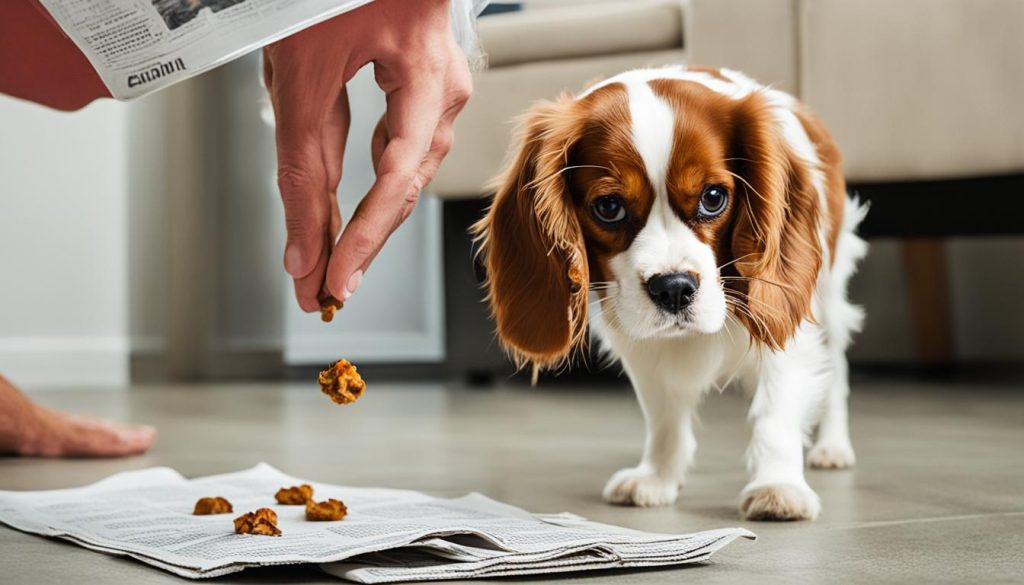
Creating a daily schedule is also beneficial for your pup’s training process. This schedule should include specific times for feeding, housetraining, sleeping, and playing. By establishing a routine, you can help your puppy understand your expectations and reinforce the desired behaviors consistently.
Leash Training and Advanced Commands
Leash training is an essential part of Cavalier King Charles Spaniel training. By using positive reinforcement techniques, you can teach your dog to walk on a loose leash and follow your lead.
To begin leash training, start by introducing your dog to the leash and collar in a calm and positive manner. Allow your dog to sniff and explore the leash before attaching it to their collar. This will help them become familiar and comfortable with the leash.
When starting the actual training, use food as a lure and reward. Hold a treat in your hand and let your dog follow it while you walk. This will encourage them to stay close to you and walk alongside you.
As your dog walks beside you, reward them with praise and treats. This positive reinforcement will reinforce their desirable behavior and make them eager to continue walking on a loose leash.
It’s important to keep the training sessions short and fun to maintain your dog’s focus and motivation. Start with short walks in a quiet and familiar environment, gradually increasing the duration and difficulty as your dog becomes more comfortable and obedient.
In addition to leash training, you can also introduce advanced commands to further enhance your dog’s obedience skills. Basic commands such as sit, down, stay, come, and wait are essential for a well-trained Cavalier King Charles Spaniel.
Remember to always use positive reinforcement techniques, such as treats, praise, and petting, to reward your dog for following these commands. This will create a positive association with the commands and motivate them to perform them consistently.
By focusing on leash training and teaching advanced commands, you can ensure that your Cavalier King Charles Spaniel becomes a well-behaved and obedient companion. With patience, consistency, and positive reinforcement, you’ll be amazed at the progress your dog can make.
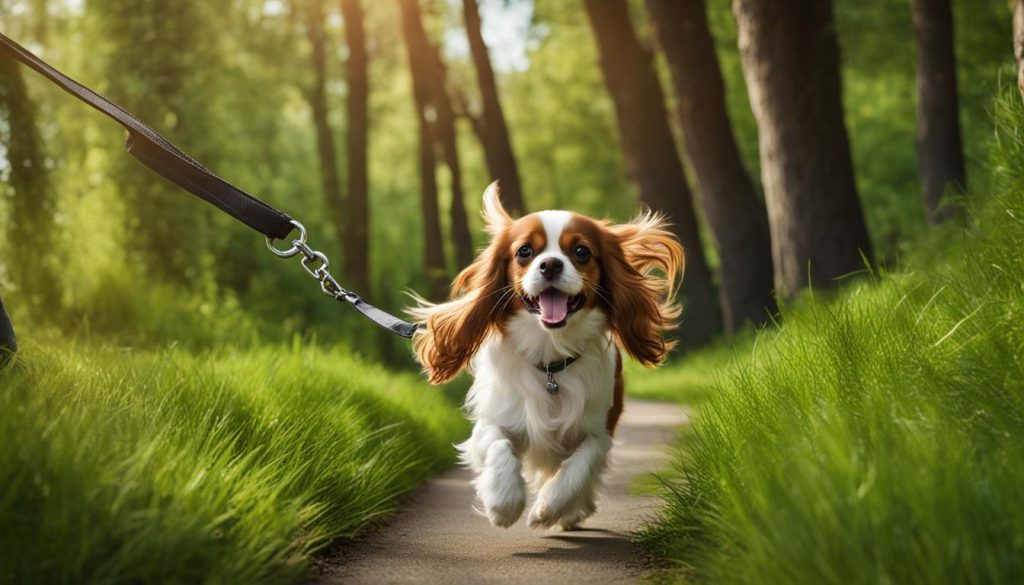
Conclusion
Cavalier King Charles Spaniel training is an essential part of their development and ensures they grow up to be well-behaved and happy companions. By following a positive and consistent training approach, you can establish a strong bond with your CKCS while teaching them good behavior.
Setting clear goals from the beginning of your Cavalier King Charles Spaniel training journey is crucial. Whether it’s housebreaking your CKCS or teaching them basic commands, having specific objectives helps keep you focused and motivated. Remember to be patient and persistent, as training takes time and consistency.
Positive reinforcement is a highly effective technique when it comes to training your CKCS. Rewarding good behavior with treats, praise, and affection encourages your dog to repeat those actions. Avoid using harsh or punitive methods, as they can harm your dog’s trust and hinder their learning process.
Lastly, socialization plays a vital role in your CKCS’s training. By exposing them to various environments, people, and other dogs, you help them develop good social skills and prevent behavior issues in the future.
Incorporating these dog training tips into your CKCS’s daily routine will lead to a well-trained and obedient companion who brings joy and happiness to your life.
FAQ
How important is socialization for Cavalier King Charles Spaniels?
Socialization is crucial for Cavalier King Charles Spaniels as it helps them develop good behavior and become well-adjusted adults. It is essential to expose them to various people, sounds, and situations during their critical socialization period from 3 to 12 weeks old.
When should I start training my Cavalier King Charles Spaniel?
Training should begin as early as possible. Start with basic manners like housetraining, crate training, and discouraging unwanted behaviors. By setting clear goals and using positive reinforcement, your puppy will quickly learn and respond to commands.
What are some important commands to teach my Cavalier King Charles Spaniel?
Some basic commands to teach your Cavalier King Charles Spaniel include sit, down, stay, come, and wait. These commands can be easily taught using positive reinforcement techniques and short training sessions filled with praise and rewards.
How can I leash train my Cavalier King Charles Spaniel?
Leash training is an essential part of your Cavalier King Charles Spaniel’s training. Use food as a lure and reward to teach them to walk on a loose leash and follow you. Keep training sessions fun and short to maintain their focus and motivation.
What is the importance of positive reinforcement in training my Cavalier King Charles Spaniel?
Positive reinforcement is a highly effective training method for Cavalier King Charles Spaniels. It involves rewarding desired behaviors with treats or praise, which encourages them to repeat those behaviors. This positive approach builds a strong bond between you and your dog and makes the training process enjoyable for both of you.

